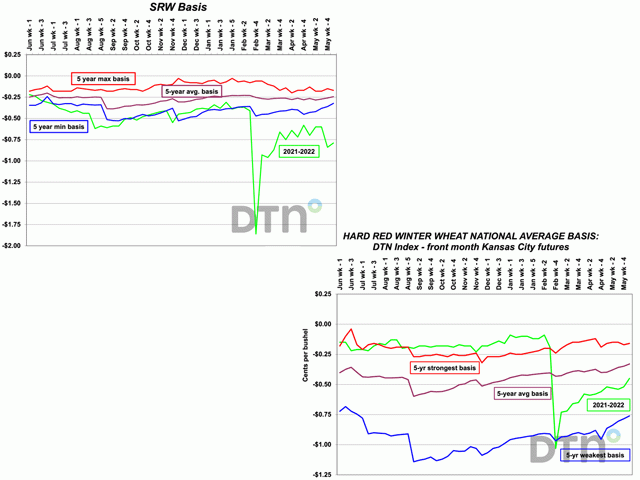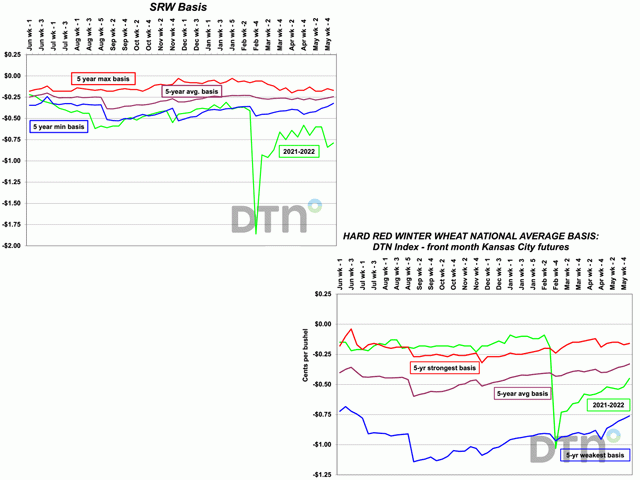Market Matters Blog
Old Crop Year for HRW, SRW Wheat Ends; Basis Says Good Riddance
As the old-crop year ended on May 31 for hard red winter (HRW) and soft red winter (SRW) wheat, the basis for both was trying to stage a recovery after the Russian invasion of Ukraine Feb. 24 sent winter wheat futures sharply higher as markets reacted to agriculture companies in Ukraine ceasing operations and the closing of ports there. In turn, basis dropped as many elevators were not willing to take on the high wheat flat price, especially with the two winter wheat markets closing limit up.
The next day, Feb. 25, wheat markets turned the other way, closing limit down ahead of the weekend and again over uncertainty as to how long the war would continue and, mainly, how long wheat commitments would be held up from shipping out of Ukraine ports.
The following week, futures markets were on fire again. For the week ended March 4, May Kansas City wheat gained $3.235 and May Chicago wheat gained $3.4925. However, the basis didn't fare well.
On Friday, Feb. 25, the DTN national average SRW wheat basis was 41 cents under the May futures. A week later, on March 4, the basis sunk to $1.86 under the May futures. HRW wheat basis on Feb. 25 was 19 cents under the May and on March 4 had fallen to $1.03 under the May.
Many buyers simply pulled their cash bids altogether at that time, which left the producer unable to market his grain on the days that took place, which was most of that week. The Kansas City milling wheat spot market, which posts the values of spot premiums for ordinary proteins through 14% proteins every day, reported no bids in the closing daily report March 4. I do not remember ever seeing that happen before.
P[L1] D[0x0] M[300x250] OOP[F] ADUNIT[] T[]
Finally, on March 8, buyers began to come back to the market and post basis bids, but many moved the basis bids to the July futures or September futures as the front-month May futures continued to be volatile as the war raged on. For the week ended March 11, May Chicago wheat closed down $1.02 1/2, Kansas City May closed down $1.25 1/4.
As buyers were bidding using different futures months than "normal" the winter wheat basis levels especially became hard to define and caused a distortion of sorts in the DTN national average basis. By the time the crop year ended on May 31, both winter wheats were unable to climb back, especially SRW wheat.
Besides the war still affecting the markets, some of that recent basis weakness seen in the last month of the old-crop year came from lack of U.S. export business. In the recent weekly USDA Export Sales and Shipments report for the week ended May 26, HRW wheat exports were dismal again and with five more days to report in the old crop year, 2020-2021 exports will likely not meet USDA expectations. But, given the big drop in futures the past few weeks and lower export winter wheat basis, SRW wheat is actually the cheapest FOB export wheat now according to analysts.
WHAT LIES AHEAD FOR WINTER WHEAT
Heading into the new-crop year, basis started out weaker and may take some time to recover given that new-crop HRW wheat harvest has started in the southern states. U.S Wheat Associates noted in their weekly harvest report, "Harvest is slowly progressing with widespread rain in Texas and Oklahoma. Harvest is 24% complete in Texas and 14% in Oklahoma. Significant rain in Kansas (9-10 inches) has slowed crop progress and test cutting is not expected to begin for another week to 10 days. SRW wheat harvest is 10% complete in Alabama and nearly 80% of the SRW crop is now headed."
In the March 31 Prospective Plantings report, USDA estimated the 2022 winter wheat planted area at 34.2 million acres, up 2% from last year but down less than 1% from the previous estimate. Of this total, about 23.7 million acres are HRW wheat, 6.89 million acres are SRW wheat, and 3.62 million acres are white winter wheat.
USDA's National Agricultural Statistics Service (NASS) provided its first forecast of 2022-23 U.S. winter wheat production in the May 12 Crop Production report. Winter wheat production overall is projected down 8% to 1.174 billion bushels (bb). Average yield is estimated at 47.9 bushels per acre (bpa), down 2.3 bpa from last year. Even though planted area was up, area harvested is forecast down 4% from last year at 24.5 million acres as a result of higher abandonment in several states. HRW wheat production is forecast at 590 million bushels (mb), down 21% from 749 mb last year, while SRW production is projected at 354 mb, down 2% from 361 mb in the previous year.
As harvest progresses further along, the market will keep watch on any weather-related quality issues that would affect basis. There is already talk among winter wheat traders that they are starting to see more weather concerns over vomitoxin issues for SRW wheat areas. Tennessee and Kentucky reported seeing isolated areas for now, but upcoming weather may cause that to spread. Also, add talk of sprout issues in central Oklahoma to the mix of current concerns and likely issues in southwest Kansas, with any quality issues easier to define at harvest as crop samples are tested.
If you add it all up, there is a big question mark as to whether or not winter wheat basis can recover from its poor showing at the end of the old-crop year. Demand from the milling market and harvest quality will decide.
Mary Kennedy can be reached at mary.kennedy@dtn.com
Follow her on Twitter @MaryCKenn
(c) Copyright 2022 DTN, LLC. All rights reserved.






Comments
To comment, please Log In or Join our Community .